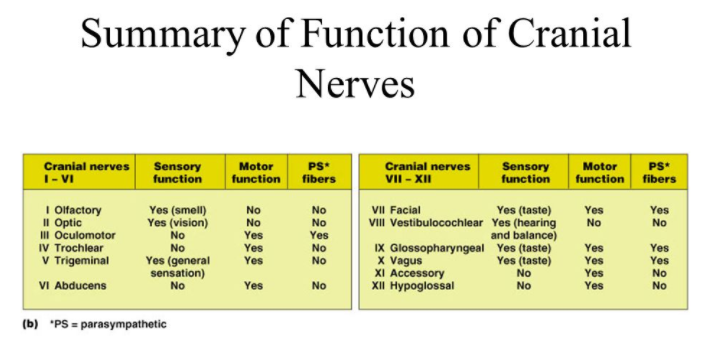The cranial nerves are pairs of nerves which connect the brain to various areas of the neck, head, and trunk. There are twelve of them, with each one named to differentiate them.
Individual cranial nerves also have a corresponding Roman numeral. These are between I and XII, and are based on where they are from front to back. For instance, the olfactory nerve is closest to the front of the head, so this has the Roman numeral I.
The function of these nerves is generally categorised as being either motor or sensory. Motor nerves control the function and movement of muscles or glands, whereas sensory ones deal with touch, hearing and smell.
Where do the cranial nerves originate?
Two of the cranial nerves originate in the cerebrum, which sits above the brain stem. They include the olfactory nerves and optic nerves.
The other ten cranial nerves start in the brainstem, which connects the brain and spinal cord.
What are the types of cranial nerves?
These are the twelve cranial nerves together with the function they’re responsible for:
- Facial nerve: Facial expressions and sense of taste
- Hypoglossal nerve: Ability to move your tongue.
- Olfactory nerve: Sense of smell
- Optic nerve: Ability to see
- Oculomotor nerve: Ability to move and blink your eyes
- Auditory/vestibular nerve: Sense of hearing and balance
- Trigeminal nerve: Sensations in your face and cheeks, taste and jaw movements
- Trochlear nerve: Ability to move your eyes up and down or back and forth
- Abducens nerve: Ability to move your eyes
- Glossopharyngeal nerve: Ability to taste and swallow
- Accessory nerve (or spinal accessory nerve): Shoulder and neck muscle movement
- Vagus nerve: Digestion and heart rate
Do you regularly see patients presenting with neurological issues?
Then PDUK’s Five Day Patient Assessment Workshop Online course may well be for you.
Aimed specifically at all disciplines of nurses, medical students, physiotherapists, health visitors and other healthcare professionals it’s a very hands-on course with students required to have access to their own (or borrowed) examination equipment. Participants will also need to provide someone to act as their patient for examination practice (please make sure you read the Important Notes part of the course description carefully).
The 5-day course takes place entirely online and is worth 35 hours of CPD. A PDUK certificate of attendance will be issued to all participants to reflect days attended.
This is one of our really popular courses due to the range of topics covered, and spaces are limited. Therefore, we strongly advise to get booked up as early as possible.
Prefer to learn face-to-face?
Now that COVID-19 restrictions are easing, we’re offering more and more of our courses in person as well as online. This course is one of them. For more information, please click here.








